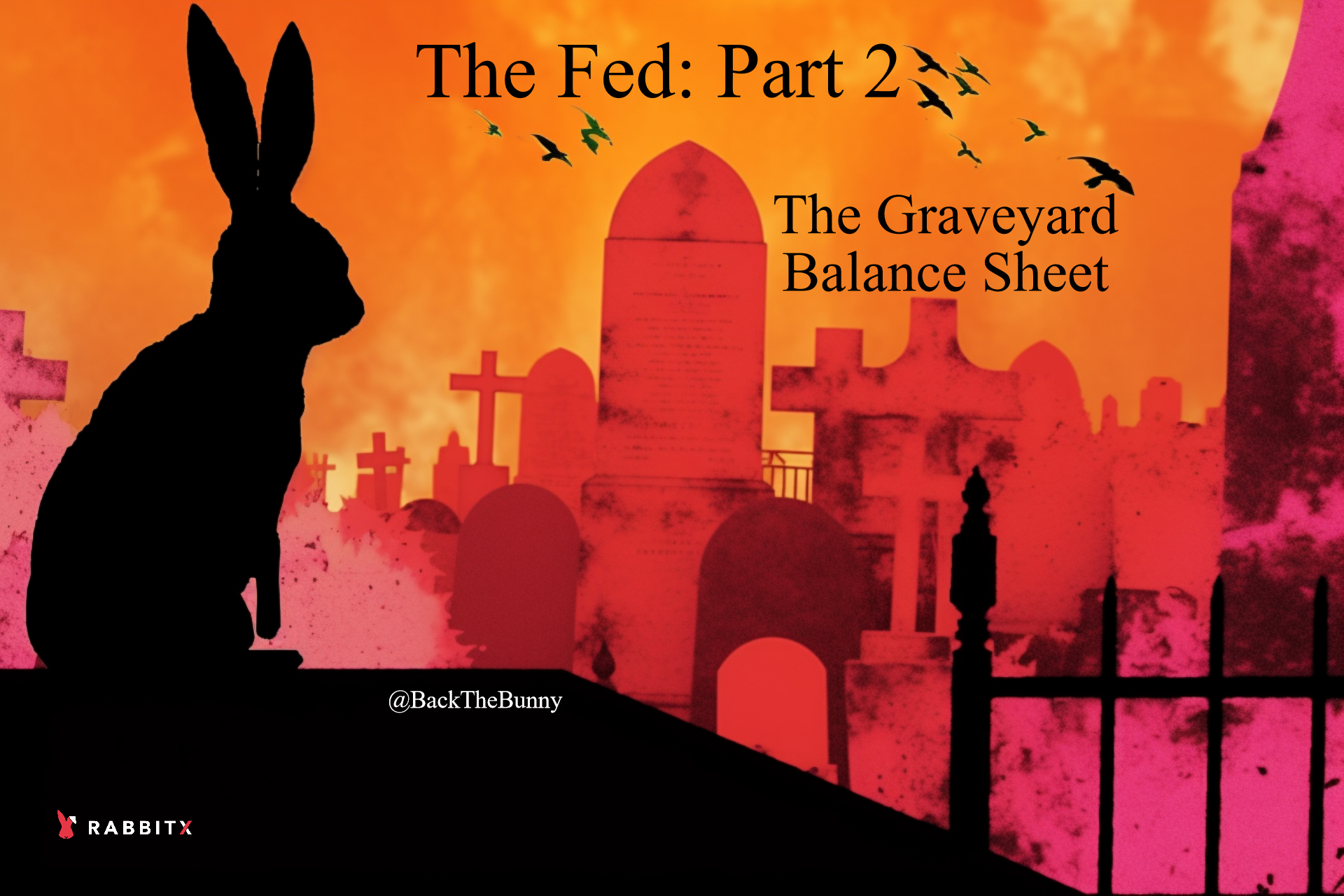In The Fed: Part 1, I covered the psychological priming of the Fed and why QE isn’t money printing, but a headline-grabbing manipulation.
What about the other side of the action: the Fed's balance sheet. What happens to bonds after they're swapped?
They're sent to the graveyard.
Each bit of info you absorb about this institution exposes how they're at most a flamboyant tool for fiscal.
I recommend you give Part 1 and Part Zero a read after this, as this piece complements and builds upon the mechanics and psychology of both. It’s important to approach this series with a fresh mind.
The Fed’s Balance Sheet Is a Graveyard
QE is an asset-swapping game and it acquires bonds in exchange for cash, reorganizing bank balance sheets (BS) while leaving total assets in the world the same. What happens to these bonds when the Fed whisks them away?
“Wait, the Fed BS increases from the bonds. The banks lose bonds but get cash; their total assets stay the same. So QE is actually asset creating for the financial world. Bank assets stay static, Fed assets go up.”
At first blush, you’d be right…

However the Fed’s BS is not something that exists in economic reality. Stay with me here.
It’s a graveyard of dead assets, stuck in purgatory. Take this colorful upcoming metaphor seriously, it illustrates what’s happening.
Imagine there was an alien technology that could exchange a dead person for a living person. It took dead people buried in a graveyard and brought them to life, but one living person would have to be put in the graveyard for every dead person that’s revivified.
How it works:
- The living person isn’t killed, they’re simply locked in the graveyard while the dead person is brought to life.
- The living person cannot leave the graveyard. He cannot participate in the world or do anything with anyone. He’s still technically alive though.
- The living person can only be released back into society if he is swapped with the dead person, who then returns to being dead and buried in the graveyard.
What would happen to the population and GDP of a city if the aliens swapped 1M dead people from the graveyard for 1M alive people?
- The population would technically explode. Look at how many more people there are! The 1M alive people are caged and can’t do anything, but they still officially exist and are counted in the census.
- The dead people do mostly the same things of the living ones they replaced. They don’t reduce or add to the preexisting activity of the living ones: they work, go to school, go out, etc. They’re not harmful to the economy, but they’re not more productive either. GDP remains the same.
- You changed some characteristics of the people in society, and the chart of people alive absolutely skyrocketed, but the amount of people interacting in the economy stayed the same.
GDP and economic activity of the area where the alien’s did their swap is unchanged… despite doubling, tripling, etc the population. But you get a big juicy census chart that shows your population went absolutely parabolic. This alien technology must be doing something big!
This is what the Fed does. This is the game that produces shock and awe.
Every Davos CNBC type will obsessively emphasize the census population metric, rather than any real impact to liquidity and the economy.
This is a Pavlovian game.

The ‘alive’ person stuck in the graveyard exists as a vanity metric for the population, but he might as well be dead. He is not part of society or the real world anymore, and he can only return when he replaces the dead person he swapped with. This is QT in a nutshell.
When the Fed brings one thing to life, it always kills something else.
Always remember this when you see its swapping hijinks. Notice what assets are going to die as much as you notice what's temporarily being brought to life.
A bond on the Fed’s BS is a person trapped in the graveyard.
The Fed’s BS is a burial ground that’s advertised as a thriving metropolis.
It’s where once-alive assets are kept in purgatory until they actually die (expire) or are swapped back to life for cash (the cash then dies).
Every single asset on the Fed’s BS is effectively a dead body. When those bonds are bought via QE, they might as well be buried in the backyard. They cease to exist in financial reality anymore.
Nobody can loan against them, trade them, repo them, etc.. They still exist, like the alive person stuck in the graveyard, but they are not a part of the financial world anymore. If they’re swapped back to life, then the cash the Fed swapped them for dies. Homeostasis cannot be denied.
I am reinforcing and rephrasing this repeatedly and illustrating with metaphors because this is what genuine 1st-principles rejection of an indoctrinated belief requires to unlearn it.
It’s foreign. It's weird. It's "wtf is this Bunny account going on about.”

When you see the Fed do anything, remember:

Another illustration of the Fed graveyard: swap lines.
Swap lines are a USD loan from the Fed to a foreign central bank (FCB). The FCB exchanges a commensurate amount of its currency for USD. Here’s how it works:
- The Fed takes the foreign currency and holds it on the FCB’s balance sheet. The foreign currency is now locked in the graveyard, out of circulation.
- The Fed sends USD to the FCB
- The FCB loans this USD to banks and must repay the loan in <3 months.
This is a 1:1 collateralized loan, with interest. Net currency in the world remains the same.
A DeFi translation of swap lines:
Picture depositing $1M of JPY to get $1M veUSD.
The veUSD can be used for up to 3 months, then must be returned with interest. Then the $1M JPY is given back to you and the veUSD is burned.
Maybe you're productive with the veUSD and make money with it, maybe you're not. The 2nd-order effects may create or lose money (this is always a truism for any loan), but the burning/minting action does not create more money
Or think how DAI is minted on Maker; you deposit collateral, you borrow DAI, you must burn the DAI to get the collateral back. Both the DAI you minted and the collateral never exist actively onchain at the same time.
You can think of it like a DeFi bridge too. When you deposit BTC and get WBTC, that BTC is stuck in the cemetery, locked in the bridge contract until freed.
Fed swap lines are a collateralized debt position (CDP) that must be swapped back in 3 months. Nothing was given away here. Unless you think issuing WBTC is “printing BTC” too.
Similar to its QE psychological kung fu, monetary policy yet again played swap games with another asset, and its "thriving metropolis" is in the headlines again.
Please stop simping over this institution. Become a Fed disrespecter.
Fractional reserve banking is when more is lent out than what’s received. That's credit creation. That's actually making new dollars, AKA "money printing". Birthing more assets.
Fiscal policy (congress) money prints. Commercial banks money print.
But when the Fed’s BS goes up, it foments a frenzy. An alien technology playing with the census. And the population metric gets all the attention.
Please share and spread the word.
The Fed, Part Zero: Become a Fed Disrespecter
The Fed, Part 1: QE Isn’t Money Printing, It’s a Game
Follow @BackTheBunny


